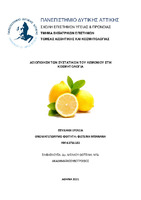| dc.contributor.advisor | Mellou, Fotini | |
| dc.contributor.author | Μπανανή, Φωτεινή | |
| dc.date.accessioned | 2021-07-22T07:09:22Z | |
| dc.date.available | 2021-07-22T07:09:22Z | |
| dc.date.issued | 2021-07 | |
| dc.identifier.uri | https://polynoe.lib.uniwa.gr/xmlui/handle/11400/899 | |
| dc.identifier.uri | http://dx.doi.org/10.26265/polynoe-750 | |
| dc.description.abstract | Αυτή η εργασία πραγματεύεται τη σπουδαιότητα του φρούτου C. limon στον τομέα της Κοσμητολογίας καθώς και τη δράση του ως αντικαρκινικό, αντιαλλεργικό, αντιμικροβιακό, αντιφλεγμονώδες, αντιπαρασιτικό και αντιοξειδωτικό μέσα από μελέτες αλλά και πειράματα που έχουν πραγματοποιηθεί όπου ιδιαίτερα σημαντικό ρόλο φαίνεται να παίζει η μεγάλη περιεκτικότητα του φρούτου σε λιμονένιο. Παρουσιάζονται μέσα από μια σύντομη ιστορική αναδρομή οι χρήσεις που είχε και έχει το λεμόνι σε διάφορα μέρη του κόσμου και από διάφορους λαούς. Επίσης αναλύεται η χημική σύσταση καθώς και το μεταβολικό προφίλ κάθε τμήματος του φρούτου. Αναφέρονται οι μορφές με τις οποίες μπορούν να χρησιμοποιηθούν τα συστατικά του στην Κοσμητολογία, και κυρίως το αιθέριο έλαιο λεμονιού, και πειράματα που αποδεικνύουν τη δράση του ως ενισχυτής διείσδυσης βιταμινών στο δέρμα, ως αντιγηραντικό, ως μικροβιοκτόνο κατά του Staphylococcus epidermidis αλλά και οι ευεργετικές ιδιότητες του ασκορβικού οξέος το οποίο περιέχει. Ειδικότερα εστιάζει στη χρήση του C. limon στα καλλυντικά με σκοπό όχι μόνο τη συντήρηση και το άρωμα αλλά τις δράσεις του στο δέρμα. Επιπλέον, αναπτύσσονται οι κίνδυνοι που εγκυμονεί η λανθασμένη χρήση ουσιών του C. limon, η ασφαλής χρήση τους και κάποιοι έλεγχοι γονοτιξικότητας και καρκινογένεσης. Τέλος, αναλύεται η φωτοτοξικότητα του χυμού λεμονιού πειραματικά, η δράση των φουροκουμαρινών καθώς και οι έρευνες που θα πρέπει να διεξαχθούν στο μέλλον έτσι ώστε να διασφαλιστεί η απόλυτα ασφαλής χρήση και αξιοποίηση όλων των ευεργετικών ιδιοτήτων του, όπως του λιμονενίου το οποίο παρά την αντιβακτηριακή του δράση φαίνεται να εμφανίζει τοξικότητα κατόπιν επεξεργασίας. | el |
| dc.format.extent | 57 | el |
| dc.language.iso | el | el |
| dc.publisher | Πανεπιστήμιο Δυτικής Αττικής | el |
| dc.rights | Αναφορά Δημιουργού - Μη Εμπορική Χρήση - Παρόμοια Διανομή 4.0 Διεθνές | * |
| dc.rights.uri | https://creativecommons.org/licenses/by-nc-sa/4.0/deed.el | * |
| dc.subject | Λεμόνι | el |
| dc.subject | Κοσμητολογία | el |
| dc.subject | Καλλυντικά | el |
| dc.subject | Κίτρο | el |
| dc.subject | Limon | el |
| dc.subject | Citrus | el |
| dc.subject | Λεμονιά | el |
| dc.title | Αξιοποίηση των συστατικών του λεμονιού στην Κοσμητολογία | el |
| dc.title.alternative | USE OF LEMON INGREDIENTS IN COSMETOLOGY | el |
| dc.type | Πτυχιακή εργασία | el |
| dc.contributor.committee | Papageorgiou, Spyridon | |
| dc.contributor.committee | Κίντζιου, Ελένη | |
| dc.contributor.faculty | Σχολή Επιστημών Υγείας & Πρόνοιας | el |
| dc.contributor.department | Τμήμα Βιοϊατρικών Επιστημών | el |
| dc.description.abstracttranslated | This paper presents the importance of the C. limon fruit in the field of Cosmetology as well as its anti-cancer, anti-allergic, antimicrobial, anti-inflammatory, antiparasitic and antioxidant effects through studies and experiments that have been carried out. Those studies suggest that those effects are due to the high consecration of limonin in the fruit. The uses of the lemon in different parts of the world and by different people are presented through a brief historical review. The chemical composition and the metabolic profile of each part of the fruit are also analyzed. The forms in which its ingredients can be used in Cosmetology, and more specifically the essential oil of lemon are presented. There are also mentioned experiments that prove its action as a penetration booster of vitamins through the skin, as an anti-aging factor, as an anti-microbiotic against Staphylococcus epidermidis and the properties of ascorbic acid which it contains.
It focuses on the use of C. limon in cosmetics not only for its fragrance but also for its effects on the skin. In addition, the risks of misuse of C. limon substances that have been reported and its safe use, the genotoxicity and carcinogenicity reports are discussed. The phototoxicity of lemon juice is analyzed, the action of furocoumarins as well as the researches that should be carried out in the future in order to ensure the absolutely safe use and utilization of all its beneficial properties, such as limonene which despite its antibacterial action appears to show toxicity after its procedure. | el |


